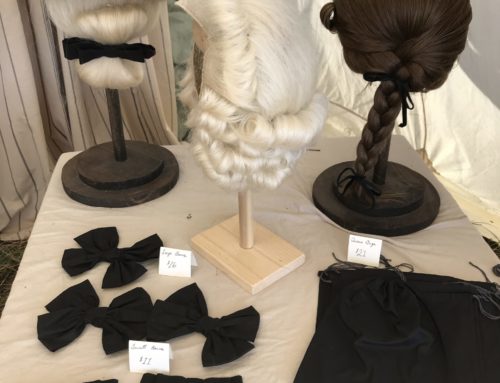Part One – The Most Common Types of Wigs
There are a variety of reasons people seek out wigs – to change their appearance, to better capture the physical characteristics of a character for stage, screen or re-enactment, to cope with hair loss or to simply have fun. The reasons for wearing a wig often dictate the type of wig someone purchases, and here we’ll discuss four different types of wigs and their characteristics.
Type 1 – Fashion/Street Wigs
These wigs are the most common, and are usually pre-styled into a fairly permanent look. They are machine made and have a “stretch cap” which means the the back of the wig is mostly elasticized to allow the wig to fit a variety of head sizes. Most of the wigs available for Halloween and costumes also fall into this category. Fashion wigs run the gamut from very cheap to very expensive, and come in almost every style and color imaginable. They are the easiest to buy and the easiest to wear – you just pop them right onto your head!
The drawback to these wigs is that they often look very unnatural, particularly the most economical varieties. This is due to several factors – machine made wigs tend be very thick as they require a lot of hair to hide the under-structure of the wig and the wearer’s own hair underneath. They also have fairly abrupt and heavy hairlines which are most often hidden with bangs. That means that any style that requires the wig hair to be worn pulled back from the face or in an updo is going to look fairly unnatural and “wiggy”. However, for a simple desire to quickly change hairstyles for a day or complete a costume, these wigs are a great choice.
Type 2 – Machine Knotted Wigs
For consumers needing a more natural looking wig, there is the option of buying a machine knotted wig, which are mehcanically produced and designed to be wash-and-wear. In this case, knotting refers mostly to the fact that they are constructed from single knots of hair tied into a denser mesh foundation rather than an elasticized wig cap covered in strips of hair, known as “wefting.” Most wigs mentioned in the first category are wefted, as this is cheaper and qicker to produce. In contrast to this, the machine knotted style leads to a more even spread of hair across the head, and looks far more natural.
These wigs are more expensive than the wefted stretch-cap wigs. They also tend to come in fewer styles and are less common than wefted wigs. Machine knotted wigs are usually better suited to those looking for a natural street wig, particularly in cases of hair loss. The biggest draw back to these is, again, that they typically suffer from the same unnatural hairline issues of fashion wigs and usually require bangs in the front to help hide the hairline.
Type 3 – Monofilament and “Lace Front” Wigs

A machine-made lace fronted wig. Note the thickness and shine of the machine lace.
Some wigs have a “monofiliament top” and a wefted back – think of these as a hybrid of the standard wefted wig and the machine knotted wig. The top is thinner and It is fairly common now to find “lace front” wigs for sale in catalogs and in shops. These machine made wigs boast a piece of heavy nylon along the forehead into which hairs are punched by machine. This front allows for a softer, more natural hairline in which the hair and nylon sit on the forehead and are intended to blend into the skin.
One of the advantages to all of the wigs discussed above is that they are intended to be easy to use. They’re one-size-fits most and they come in one basic style that will endure through washing and drying. The drawback to this is that “one-size-fits-most” usually means “doesn’t fit anyone really well”.
Alongside that, wig manufacturers and online stores often utilize industry terms to make their products sound higher quality. Machine knotted wigs, for example, are frequently called “ventilated” wigs, which is a term reserved for hand-tied wigs – not machine-made ones. In recent years, the term “lace front” has become adulterated as well and is now used whenever a machine made wig has the heavy nylon edge mentioned above – these lace fronts are very different from the lace fronts used with custom wigs, as we’ll discuss below. This sort of free use of very specific terms can confuse buyers into purchasing something they didn’t intend to, leaving them with a wig that has them dissatisfied.
Type 4: The Custom Wig
The next step up the wig food chain is a custom wig or hairpiece. These pieces are constructed specifically for an individual, and are the most natural looking options. These are mostly used in film, theatre and tv, or by individuals seeking very natural or very specific wig options, such as re-enactors, impersonators, or characters like Santa.
As one might expect, these are the most expensive option for wig wear – but if made well, a custom wig or hairpiece can last a lifetime. Not only do custom pieces look very specific, they are the most natural option for most people. In addition to being hand-made and fit to the head of the wearer, these pieces also have what is called a “ventilated front”. This means that rather than the abrupt hairline featured on most wigs, these wigs have a piece of fine mesh that has tiny hairs knotted into it. These hairs follow the hairline of the wearer and give the illusion that the wig is actually growing from the scalp of the wearer.
A hand-ventilated front makes styles pushed back from the face look very natural. Unlike the monofilament topped “lace-front wigs” discussed above, these lace fronts are much more natural in appearance and are shaped to fit the individual’s actual or desired hairline. The lace is much softer and lighter weight than the heavy nylon “lace fronts” available commercially and can be tinted to blend into the wearer’s skin tone.
A final type of variant of the custom wig is what we call a “semi-custom” piece – that’s when we take a machine made wig and remove the front and top in order to replace them with carefully tailored, hand-ventilated pieces instead. We’ll get into the reasons for using a semi-custom wig more in Part Two, when we’ll discuss how to choose the right type of wig for your needs, as well as the differences between human-hair and synthetic wigs.
See you next time!
Find and follow us online using Facebook, Pinterest, and don’t forget to sign up for our newsletter!


